Introduction
Engraving, controlled surface abrasion, is achieved by blasting the surface with fine high speed abrasive particles which wear away the surface. The engraving pattern is achieved by protecting the surface that is not to be worn away, with a film of material that resists the abrasive. After blasting this Resist is removed to expose the surface engraved image. Modern Resists ( or single use stencils) can carry very fine detail so there is virtually no limit to the designs that can be engraved.
Step one - Produce suitable art work.
The art work or engraving design, is drawn and scaled to suit the piece selected. Extensive use is made of computer graphics to give quality, speed and creative freedom. The art work ranges in complexity from simple text alone, to inclusions of suitable catalogue clip art, custom logos, and on up to half tone photographs.
Simple text can be of any length or type face/s. (Cost is not a direct function of the number of letters.)
The studio has a large file of clip art from which a graphic could be used to enhance simple text.
The inclusion of a customer logo will usually first require a degree of image redrafting to make the art suitable for engraving. Note that all engravings are in Black & White. White where the surface has been engraved (frosted). So that a coloured logo eg. needs redrafting into solid black and solid white. ( Or half-tone grey )
![]()
![]()
![]()

Logo designs can be presented to the Studio as CD files, hard copy or anything that can be placed in a flat bed scanner. CD files, eMail files should be to a generic file standard eg. jpg, tiff, gif at 2Mb original file size minimum. (Suitably compressed for emailing ). Logos taken from web site banners are most often not of sufficient size or detail. The initiation costs will therefore depend largely on the quality of the art work presented.
Shades of grey, in logos or more particularly photographic presentations, are achieved by half-toning. That is a grey is converted into a field of dots, which, from a short distance away is seen as a plain grey. (Apart from solids all printed images are half-tones. The smaller the dots the finer the detail that can be represented but the proportion of the area covered by the dots will remain the same for the same shade of grey) In engraving a surface is either engraved or not, black or white, so half-toning is used to produce the scales of grey present in a photograph. Unlike printing only black and white grey scale engravings can be made; not colour. Original colour photographs have then to be converted into black and white, careful to maintain contrast between complementary colours, and to adjust the levels of shadow, highlight and intermediate greys to create an overall grey scale range that is engravable. Although the Studio would as a matter of course digitally remove obvious blemishes, scratches etc. a degree of digital image modification and re-composition can be requested.

Examples of engraved photographs -
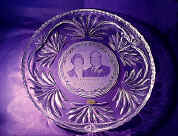
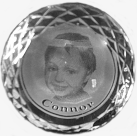

Step two - manufacture a Resist
Resist material is basically a thin film of PVC. This PVC has short polymer chains held together by Diazo molecules. Diazo dizzolves in water unless first fixed with ultra violet light. So a sheet of resist film immersed in water before being exposed to UV light would simply wash away as the short PVC polymer chains break up. If however the resist film is first exposed to UV light it remains waterproof. Any shielding of the film from UV light, say in a pattern from an image transparent negative, will result in unexposed parts of the resist washing away in the water leaving behind an image in the resist. ( This is not unlike the patterning process used in the manufacture of electronic devices )
The engraving litho negatives are produced directly from the computer art work down loaded to an image setter.
Step three - Engrave a surface
The resist has two layers, the PVC resist layer holding the image and a flexible backing layer holding all the parts of the image together like the thousands of dots in a half tone.
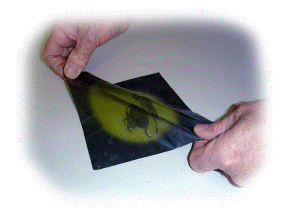
The PVC layer is glued onto the surface with a sugar and starch based gum. The flexibility of the backing facilitates the resist to stretch round compound curves without creasing. Such compound curves are common on crystal pieces.
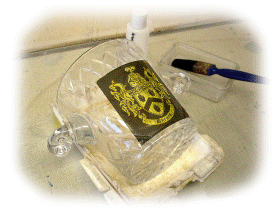
When the gum is dry the backing is peeled away leaving the PVC resist film alone on the surface.
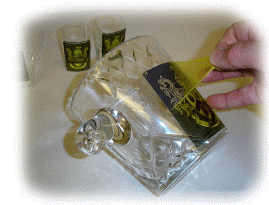
The surface is then blasted and the resist removed in warm water to expose the engraved image.

By using thicker PVC resist films very hard polished granite can be blasted with half tone images to produce quite exceptional stone plaques.
Stone engravings can be presented several ways :-
Blasted leaving raw stone exposed.
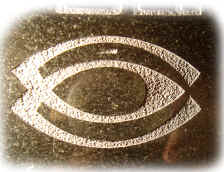
Guilding of the blasted stone. Maintains visibility when wet.
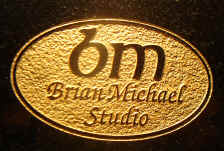
Solid colour can be added.
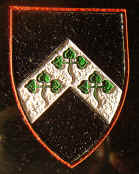
Fine deep detail engraved. Very long life even outside.
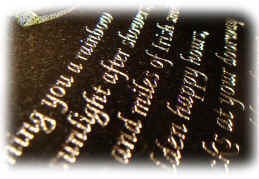
Fine stone engraving enables halftones
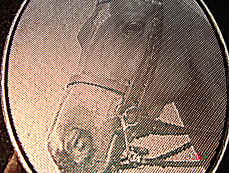
In effect any design can be engraved onto polished stone to create a truly unique and lasting item.
Mirrors can be engraved from the front, directly onto the glass, or from the back through the silvered layer. In this latter case the frosted glass exposed through the silvering can be carefully hand painted with coloured enamels to great effect.
